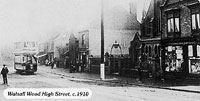Walsall Wood in history

Prior to the 19th century, Walsall Wood was the main one of three settlement areas on the outer edges of Cannock Wood, the earliest recorded community being at 'Bullings Heath' (where the Junction of Green lane and Hall Lane is now). The area now known as Coppice Wood was originally called 'Goblin's Pit Wood', and it was here that limestone was mined during the late 18th and early 19th centuries.
The canal opened as part of the Daw End Branch of the Wyrley & Essington Canal during the 19th century, to transport coal and other raw materials required by the iron and steel industries of the Black Country towns surrounding the area.
In 1841 the population of Walsall Wood numbered 900, mainly nailmakers and chain makers by trade, a home based industry at the time, the rest being mostly boatmen and brickmakers. Brickmaking, using Etruria Marl found in plentiful supply around this area, became an important industry. At one time there were six large brickyards producing the famous Staffordshire Blue Bricks.
By 1851, the population had risen to 1,142, the increase due mainly to the influx of miners working at the colliery in Shelfield. Between 1871 and 1891, the period during which Walsall Wood Colliery opened and expanded, the population rose to 3,242. Coinciding with this, the first public services were established, to serve the needs of the fast growing community (police station, gas and sewage works, a post office). The Walsall Wood Colliery was set up by a group of wealthy Walsall people with no pervious experience of mining. A lease for the land had been obtained from the Earl of Bradford, who as Lord of the Manor owned much of the land surrounding this area, and shaft sinking commenced in 1874. At the time of sinking, the Walsall Wood shafts were the largest and deepest in the Cannock Chase Coalfield. In the late 19th century the Company took over the Pelsall Coal & Iron Company, whose engineer developed and put into use one of the first coal cutting machines in the country. The mine was closed on October 30th 1964 due to the exhaustion of economic reserves of coal.

1882 saw the opening of a freight railway line which operated until 1962, and a passenger line from 1884 until 1930 operated from a station built off the Lichfield Road. A tram service was introduced in 1904 between Walsall and Walsall Wood, to be replaced in 1927 by a motor bus service. Being basically a mining community the parish church, St. John's, has on display a commemorative miners lamp inscribed with the names of the victims of the 1930 Grove Pit Disaster; there is also a stained glass window in the church dedicated to the miners of the area.
In 1921 the population numbered 8,351, by then served by a well established shopping area near the parish church. In 1966 Walsall Wood became part of Aldridge-Brownhills Urban District and was developed considerably. 1974 saw the amalgamation of the whole area with Walsall to become part of the new Walsall Metropolitan Borough. The 1981 census figures show a population around the 8,000 mark, roughly the same as in 1921.
Margaret Brice